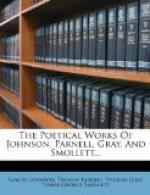His remark that the “Prospect of Eton College” suggests nothing to Gray which every beholder does not equally think and feel, is, in reality, a compliment to the simplicity and naturalness of the strain. Common thought and feeling crystalised, is the staple of much of our best poetry. Gray says in a poetical way, what every one might have thought and felt, but no one but he could have so beautifully expressed. To the spirited translations from the Norse and Welsh, the only objection urged by Dr Johnson is, that their “language is unlike the language of other poets”—an objection which would tell still more powerfully against Milton, Collins, and Young, not to speak of the “chartered libertines” of our more modern song. But a running growl of prejudice is heard in every sentence of Gray’s Life by Johnson, and tends far more to injure the critic than the poet.
In his “Elegy written in a Country Churchyard,” Gray has caught, concentred, and turned into a fine essence, the substance of a thousand meditations among the tombs. One of its highest points of merit, conceded by Dr Johnson, is essentially the same with which he had found fault in the “Ode to Eton College.” “The poem abounds with images which find a mirror in every mind, and with sentiments to which every bosom returns an echo.” Everything is in intense keeping. The images are few, but striking; the language is severely simple; the thought is at once obvious and original, at once clear and profound, and many of the couplets seem carefully and consciously chiselled for immortality, to become mottoes for every churchyard in the kingdom, and to “teach the rustic moralist to die,” while the country remains beautiful, and while death continues to inspire fear. And with what daring felicity of genius does the author introduce, ere the close, a living but anonymous figure amidst the company of the silent dead, and contrive to unite the interest of a personal story, the charm of a mystery, and the solemnity of a moral meditation, into one fine whole! We know of but one objection of much weight to this exquisite elegy. There is scarcely the faintest or most faltering allusion to the doctrine of the resurrection. Death has it all his own way in this citadel of his power. The poet never points his finger to the distant horizon, where life and immortality are beginning to colour the clouds with the promise of the eternal morning. The elegy might almost have been written by a Pagan. In this point, Beattie, in his “Hermit,” has much the advantage of his friend Gray; for his eye is anointed to behold a blessed vision, and his voice is strengthened thus to sing—
“On the pale cheek of Death smiles
and roses are blending,
And Beauty immortal awakes from the tomb.”
Nevertheless, had Gray been known, not for his scholarship, not for his taste, not for his letters and minor poems, not for his reputed powers and unrivalled accomplishments, but solely for this elegy—had only it and his mere name survived, it alone would have entitled him to rank with Britain’s best poets.




